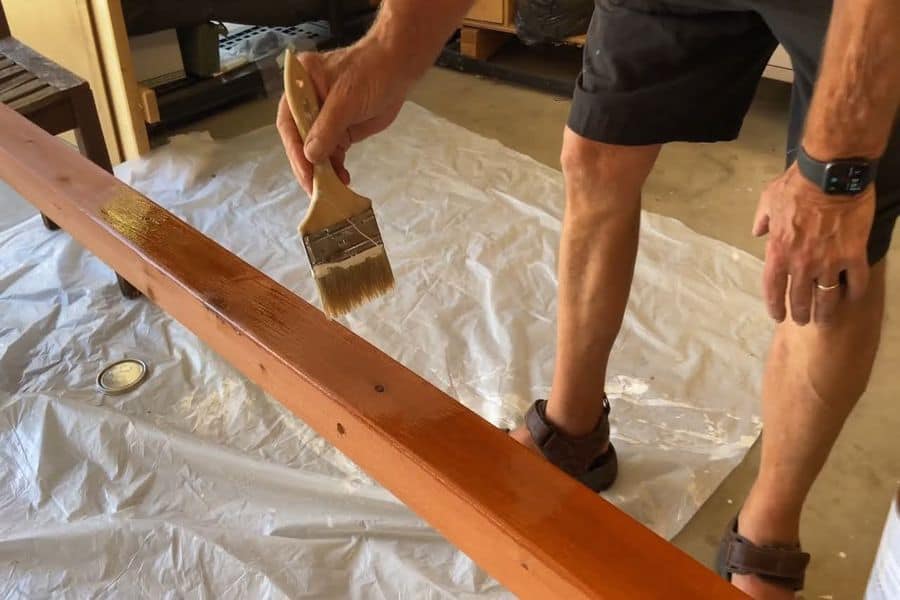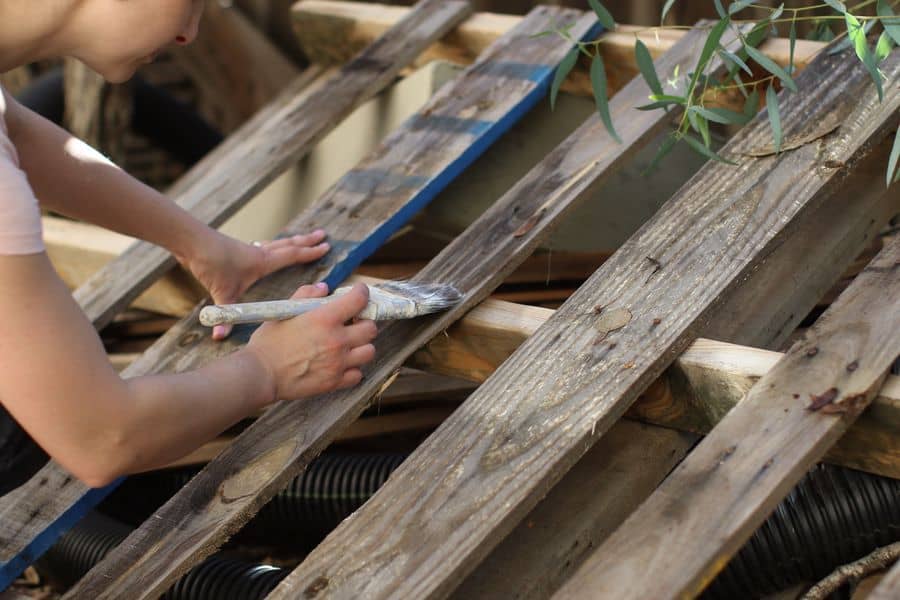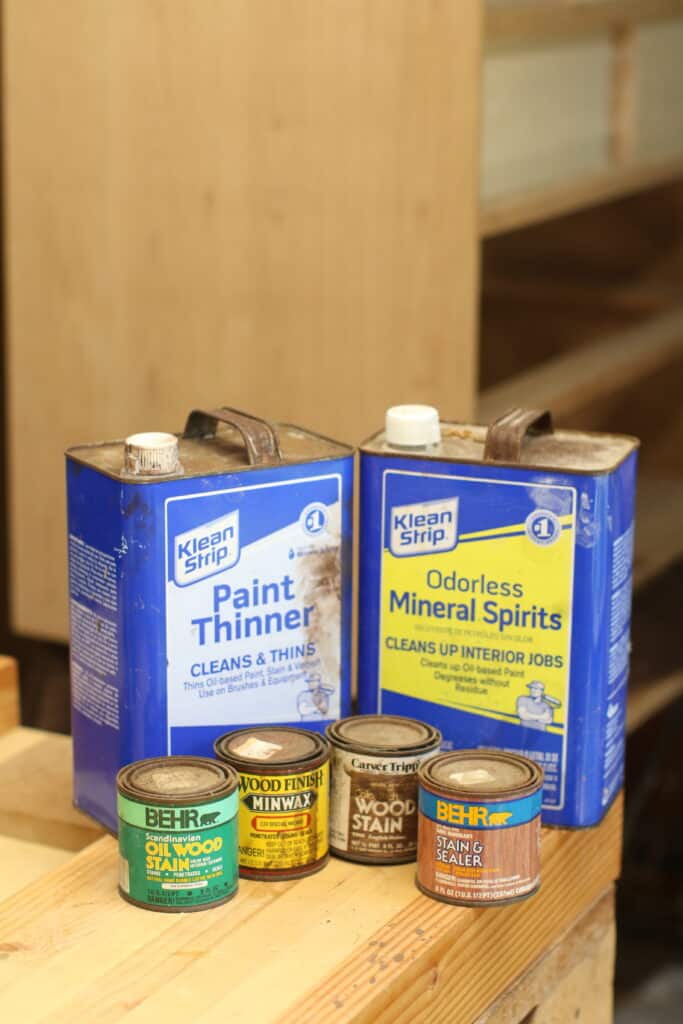This article covers the different formulations of stains and explains why they stick to your skin. It then details the methods and ingredients necessary to remove stain from skin, and ends with a few tips to keep your skin stain-free during your next wood stain project.
Contents
Getting Wood Stain Off Skin
Removing wood stain from your skin requires choosing an appropriate solvent. Commercial wood stains are either water-based, or oil-based. The formulation of the stain affects the solvent or method used to remove it.
Besides oil or water, stains also contain pigments or dyes.
- Oil-based stains include solvents, and sometimes contain proprietary ingredients used as binders.
- Water is the solvent in water-based stains.

The purpose of a solvents is to keep the stain in its liquid form until it is exposed to oxygen. Then, they evaporate into the air, leaving the pigments and dyes bonded to the wood surface.
The same process applies when wood stain is applied accidentally to the skin. As the solvents evaporate, the pigments and dyes stick to your skin’s surface. Keep reading to learn how to reverse the process.
How To Get Water-Based Stain Off Skin
Water is a solvent for water-based stain. If your stain falls in this category, you may be able to simply wash your skin with soap and water.
White vinegar is mostly water, and the acidity can help cut through the stain. Use white vinegar to get a stubborn water-based stain off your skin.
Other household products you can try to remove water-based stains are lemon juice, hand sanitizer, and make-up removing wipes.
How To Get Oil-Based Stain Off Skin
Oil-based stains are more difficult to remove from your skin than water-based stains. The drying oils used in the formulation of this kind of stain bind tightly to the surface of your skin. The stain shrinks slightly as it dries, leading to an uncomfortable tightness on your skin wherever drips or spills have dried.
- Choose a solvent. Many solvents will dissolve oil-based stain, so it’s a matter of choosing the one that is easiest on your skin and with the fewest other safety concerns. Review the list below and check your cupboards – many solvents are household staples, so you don’t necessarily need to buy something to get your skin stain-free.
- When in doubt, read the label. Many manufacturers include information on the label about what solvent to use to clean up stain. The same solvents can be used to remove stain from your skin. However, it’s generally best to start with the mildest options, moving onto harsher chemicals only if necessary.
- Gather your materials. You will need a clean rag, dish soap, running water, a household oil, the solvent of your choice, and a dry towel. Lotion is helpful to restore moisture and protect skin that has been exposed to stain, but this ingredient is optional. Bring the materials to a sink and work over the drain.
- Loosen the stain with oil. Vegetable oil, olive oil, or even an oily substance like peanut butter can all help stain detach from the surface of your skin. This will work best with stain that has been in place less than four to six hours and has not yet fully dried. Apply the oil directly to the stained area of the skin, paying particular attention to the edges of the stain. Work the oil into the skin in a gentle, circular motion, using your fingers or a clean rag.

- Dissolve the stain with solvent. Apply the solvent of your choice to a clean rag, and use the rag to apply the solvent to the stained area. Let the solvent soak into the stain for no more than a minute, then begin rubbing the stain with the rag. As the stain transfers from your skin to the rag, move to a clean area of the cloth. This will help remove the stain, rather than simply spreading it around on your skin.
- Use abrasion sparingly. A bit of salt or another exfoliant can help slough off dead skin, which will take the stain with it. A scrub brush serves the same purpose. However, abrasion alone won’t remove stain, so don’t rely too heavily on this method or you’ll end up with angry raw patches of skin.
- Wash away the dissolved stain. When oil-based stain has released its grip on your skin, it won’t immediately drip off like water. Use soap and water to thoroughly wash the affected area, removing any loosened stain, oil, and solvent you used in the process.
- Dry and moisturize. Towel off and check the surface of your skin with your hands to verify that all the stain has been removed. Use a moisturizing lotion on the area to protect and nourish skin.
Oil-Based Wood Stain Solvents
Below are some of the most common solvents that will dissolve wood stain. They are organized by level of harshness, so start with the more mild options and move onto to stronger chemicals only if necessary.
Alcohol
For the gentlest stain removal solution, try a 70% rubbing alcohol solution. If you don’t have success, substitute something with higher concentrations of alcohol, such as 99% isopropyl alcohol.
Hand sanitizer that contains alcohol can be used to dislodge stain if nothing else is available.
If you really need to get the stain off your skin and don’t want to make a trip to the store, drinking alcohol such as vodka will also loosen dried stain, making it easier to remove.
Acetone
Acetone is an active ingredient in many nail polish removers. These products often have moisturizing elements to counteract the drying quality of acetone. You can also purchase pure acetone at a hardware store or home improvement center.
Turpentine
Turpentine has a harsh, pungent aroma. Inhaling turpentine fumes should be avoided, as it can cause dizziness or nausea. It can irritate the skin or cause an allergic reaction, but is less toxic than petroleum-based products.

Mineral Spirits or Paint Thinner
Both mineral spirits and paint thinner are petroleum products and are known to irritate the skin. While either substance will effectively remove wood stain from your skin, they should only be used as a last resort, if nothing else works.
How To Avoid Getting Wood Stain On Skin
If you’re reading this article, your skin is likely already stained. The next time you work with wood stain, follow these tips to avoid getting wood stain on your skin.
- Wear gloves. Latex or vinyl gloves should be fine for most stain applications. Pull on a pair before you even open the can of stain, and keep them on throughout the project. Change your hand protection when they start to look messy. While the stain shouldn’t penetrate an intact latex or vinyl glove, you can transfer stain to other surfaces by mistake.
- Check your gloves regularly. A splinter or snag in the wood can cause a small perforation in the glove, allowing stain to seep underneath the protective surface. While you’re absorbed in a project, it’s surprisingly easy to miss the perforation and stain that slowly seeps in. Give your gloves a once-over each time you set down your brush or roller
- Tie back hair. When loose tendrils of hair fall in your face while you’re staining, pushing them back or tucking them behind your ear is practically a reflex. If your hands are covered with stain, you’ll probably realize your mistake a moment too late. Securing hair in an elastic band or clip keeps it out of your eyes, and avoids the need to adjust with hands that may be coated in stain.
- Wipe off stain while it’s wet. No matter how careful you are, it’s likely you’ll get a splash or drop of stain somewhere on your skin. Wiping it up immediately using a clean rag won’t completely remove the stain. However, the less material the solvent has to dissolve during clean-up, the less time it will take to remove wood stain from your skin.
Conclusion
Use soap, water, and/or white vinegar to get water-based stain off skin. Use oil to loosen oil-based stains, then dissolve with an appropriate solvent. Follow the tips in this article to avoid staining your skin while working on wood stain projects.